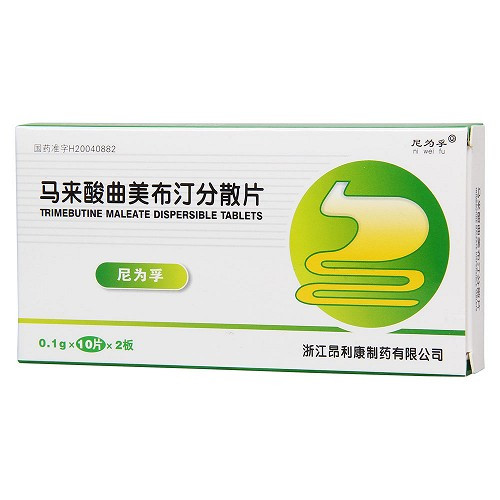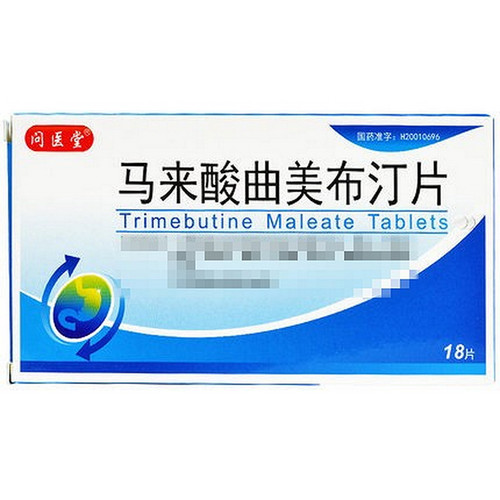Product Overview
Drug Name
Generic Name: Trimebutine Maleate Capsules
Trade Name: Haoyihaoban Trimebutine Maleate Capsules 0.1g*20 Capsules
Pinyin Code: AnTe RuiJian MaLaiSuanQuMeiBuTingJiaoNang
[Main Ingredient]
Chemical Name: 2-Dimethylamino-2-phenylbutyl 3,4,5-Trimethoxybenzoate Maleate
Molecular Formula: C22H29NO5-C4H4O4
Molecular Weight: 503.55
[Properties]
This product is a hard capsule containing odorless, bitter white granules or powder.
[Indications/Main Functions]
1. Improvement of symptoms such as loss of appetite, nausea, vomiting, fever, abdominal distension, borborygmus, abdominal pain, diarrhea, and constipation caused by gastrointestinal motility disorders.
2. Irritable Bowel Syndrome.
[Specifications]
0.1g*20 tablets
[Dosage and Administration]
1. For chronic gastritis: Take one tablet (0.1g) orally, three times daily, or as directed by a physician. 2. For irritable bowel syndrome: Take one to two tablets (0.1-0.2g) orally, three times daily, or as directed by a physician.
[Adverse Reactions]
The incidence of adverse reactions with this product is approximately 0.4%. Occasionally, symptoms such as constipation, diarrhea, bowel sounds, and oral numbness may occur. Increased liver function (GOT and GPT), palpitations, occasional drowsiness, dizziness, and headache may also occur, which may resolve after discontinuation of the drug.
[Contraindications]
This product is contraindicated in patients with allergies.
[Drug Interactions]
Information is lacking.
[Precautions]
1. Patients who develop a rash should discontinue the drug and undergo observation.
2. A clear diagnosis must be established before treatment. Use with caution in patients with other organic or space-occupying gastrointestinal diseases.
[Pediatric Use]
Safety issues have not been established. Use with caution if necessary.
[Use in Elderly Patients]
The elderly have weaker physiological functions, so caution should be exercised when using this medication.
[Overdose]
There is no experience of overdose with this product.
[Pharmacology and Toxicology]
1. Effects on Digestive Tract Motility: 1) Regulating Gastric Motility. When administered intravenously to anesthetized dogs with thoracic vagus nerve transection, 3 mg/kg of water can regularize irregular gastric motility. It inhibits pyloric motility when hypermotility is present and enhances it when hypomotility is present. 2) Inducing Propulsive Motility in the Digestive System. It has a stimulatory effect on impaired gastric emptying caused by chronic gastritis, significantly improving gastric emptying. It also has an inhibitory effect on hyperactive gastric emptying. 3) Direct Effects on Digestive Tract Smooth Muscle. It can directly act on smooth muscle even after administration of atropine, phentolamine, propranolol, and tetrodotoxin. It exhibits a noncompetitive inhibitory effect on the effects of acetylcholine in isolated guinea pig ileum. 2. Peripheral antiemetic effect: Experiments in dogs showed that while its inhibitory effect on apomorphine-induced vomiting was weak, it significantly prolonged the duration of vomiting induced by copper sulfate after intravenous injection of 3 mg/kg or oral administration of 6 mg/kg. 3. Subacute and chronic toxicity: Subacute and chronic toxicity studies: SD rats: 200, 400, 800, and 1600 mg/day; hounds: 10, 25, 50, and 100 mg/kg/day, orally for one month. Chronic toxicity studies: SD rats: 100, 200, 400, and 800 mg/kg/day; hounds: 10, 25, 50, and 100 mg/kg/day, orally for six months. In the SD rat group, mucosal disorders characterized by hyperkeratinization and excessive tissue proliferation of the gastric mucosa were observed (subacute toxicity studies: 400 mg/kg/day or higher; chronic toxicity studies: 200 mg/kg/day or higher). In the hound group, renal impairment was observed, including elevated creatinine and urea nitrogen, positive urine protein and glucose levels, and regenerative changes in renal tubular epithelial cells (subacute toxicity tests exceeding 100 mg/kg/day; chronic toxicity tests exceeding 25 mg/kg/day). However, these changes generally disappeared or were close to disappearing 12 months after discontinuation of the drug.








